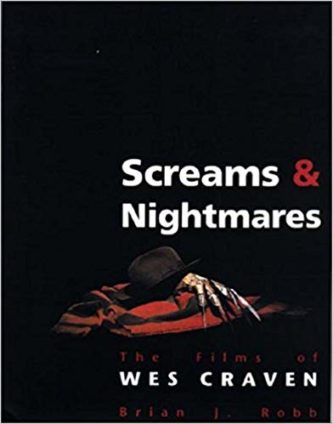 By BRIAN J. ROBB (Overlook Press; 1998)
By BRIAN J. ROBB (Overlook Press; 1998)
Fans of Wes Craven can rejoice, as this hardcover overview of his life and films is about as good as can be expected, despite being over two decades out of date. It’s fast and snappy, providing a goodly amount of background information on Craven’s films without going overboard—a good thing, as there’s frankly not a lot to be said about clunkers like SUMMER OF FEAR or DEADLY BLESSING!
…fast and snappy, providing a goodly amount of background information on Craven’s films without going overboard
Drawing on interviews with Wes Craven and his collaborators, author Brian J. Robb begins his survey with a brief look at Craven’s ultra-religious upbringing in Cleveland, Ohio. The repression and frustration fostered by that upbringing were apparently largely responsible for Craven’s turn to horror. Further rebellion was fostered in his twenties when, ensconced in an unfulfilling academic career, Craven realized he was “profoundly bored and out of place.” Yet he also feels his educational background gave him a leg up on less academically inclined horror filmmakers, and I’ll have to agree. Among Craven’s films, after all, are LAST HOUSE ON THE LEFT, THE HILLS HAVE EYES and the original NIGHTMARE ON ELM STREET, three of the most influential genre movies of all time, with Ingmar Bergman’s classic THE VIRGIN SPRING providing the unauthorized model for LAST HOUSE, and NIGHTMARE inspired (in part) by Milton’s PARADISE LOST.
Robb provides solid info about the highly tumultuous productions of the lesser-known Craven films THE SERPENT AND THE RAINBOW and SHOCKER, and also reveals that Craven was flat broke when he made A NIGHTMARE ON ELM STREET. Obviously the section on THE LAST HOUSE ON THE LEFT, even though it is extremely well informed, doesn’t come close to David Szulkin’s authoritative book on the film, and nor will the chapter on the NIGHTMARE ON ELM STREET series ever displace the numerous books available on that subject—although, not having read any of them, I found Robb’s writing about the series quite informative.
What this book also captures is Craven’s deep ambivalence about being typed as a horror movie director. If Craven is to be believed, his 1986 bomb DEADLY FRIEND was supposed to be far more subdued than it turned out, while his early years were spent trying to make non-horror films. He did eventually manage to break out of the genre with 1999’s Meryl Streep headlined MUSIC OF THE HEART (the making of which concludes this book), but it had little to no effect on Craven’s reputation.
What this book also captures is Craven’s deep ambivalence about being typed as a horror movie director.
As one who loathes the SCREAM movies I’m grateful for the slimness of Robb’s chapters on them. Yes, I know the Miramax distributed SCREAM reinvigorated Craven’s career, and horror movies in general, but that doesn’t change the fact that it and its sequels are teenybopper BS far removed form the boldness and ferocity of Craven’s finest work. Furthermore, in subsequent years Craven’s relationship with Miramax turned mighty sour, culminating in 2005’s disastrous CURSED. That film, however, falls outside this 1998 book, which thankfully focuses on Craven’s earlier and more enduring pre-1990 films.
